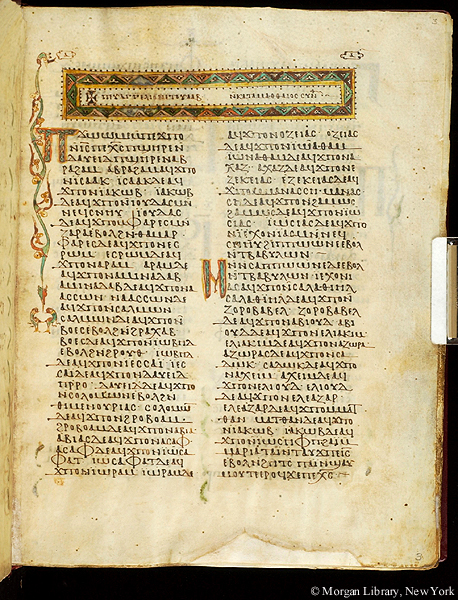
Accession number
MS M.569
Object title
Gospels.
Created
Egypt, 822-914.
Binding
Ancient binding: Upper and lower board, made of 2 layers of inscribed papyrus cartonnage, with inner layer edged with brown leather; 5 board attachments, with remains of vertical joining thread, and coarse headband tie-downs at inside tail edge of each board; covered in goatskin decorated with a panel of red leather sewn to gilt design consisting of cross in circle in in reduced rectangle, with major divisions outlined with lacings of parchment; 7 loop and peg fastenings; ex libris pasted upside down inside the upper cover; binding wormed and leather crumbling. (Binding cataloged separately as MS M.569A.)
Credit line
Purchased for J. Pierpont Morgan (1837-1914) in 1911.
Description
113 leaves (2 columns, 38-39 lines), bound : vellum, ill. ; 387 x 303 mm
Provenance
Monastery of Saint Michael (Dayr al-Malāk Mīkhāʼil); found in 1910 near the village of Hamuli, Fayyūm Province, Egypt, at the site of the Monastery of Saint Michael; purchased in Paris in 1911 for J. Pierpont Morgan (1837-1913) from Arthur Sambon, a dealer acting in behalf of a consortium of owners including a certain J. Kalebdian; J.P. Morgan (1867-1943).
Notes
Manuscript gospels written and decorated in Egypt, between 822 and 914.
Colophon: 1) fol. 113v: Original owner's name in Greek: Property of the Church of the Blessed Theotokos Mary of [Perkithoout]. 2) Second owner's name in Coptic: Property of the Monastery of St. Michael near present day Hamuli.
Fourteen leaves are wanting; no Gospel is complete; Luke is the most fragmentary.
Written area ca. 291 x 217 mm. Divisions: Red leather tab fastened by metal (copper?) to center of fore-edge at beginnings of gospels starting with fol. 39; ekthesis, major or enlarged initial, andrarely paragraphus sign setting off paragraphs; kephalaia numbers (referring to kephalaia lists preceding gospels), written small, with horizontal rule above and below, located above initial (except at fol. 31r); on fol. 66v (Luke 3:23-38), genealogy of Jesus tabulated. Exceeding letters of last line of the page written below end of the line on fols. 25r and 77r; quotations from Old Testament and certain other passages marked by a small diple in margin of each line (Cf. Quecke 1977, p. 26).
Script: Upright. 10 lines = ca. 80 mm
Superlineation: Non-standard. Punctuation: A space with or without a raised dot; raised dot with spacefiller sometimes at ends of textual units.
Collation: Signed on first and last page of the quire, top inner margin. No quire ornaments, monograms, headlines or catchwords.
Decoration: headpieces, tailpieces, coronis, paragraphus signs, major initials, signatures and page numbers, extended letters. Colors: moderate reddish orange, strong yellow, moderate yellowish green.
Marginal annotations: Various marginal signs throughout.
Another Hamuli manuscript of John in Sahidic is now at the Coptic Museum in Cairo (No. 404). For a study of the versions of John in Coptic, see Kasser.
Colophon: 1) fol. 113v: Original owner's name in Greek: Property of the Church of the Blessed Theotokos Mary of [Perkithoout]. 2) Second owner's name in Coptic: Property of the Monastery of St. Michael near present day Hamuli.
Fourteen leaves are wanting; no Gospel is complete; Luke is the most fragmentary.
Written area ca. 291 x 217 mm. Divisions: Red leather tab fastened by metal (copper?) to center of fore-edge at beginnings of gospels starting with fol. 39; ekthesis, major or enlarged initial, andrarely paragraphus sign setting off paragraphs; kephalaia numbers (referring to kephalaia lists preceding gospels), written small, with horizontal rule above and below, located above initial (except at fol. 31r); on fol. 66v (Luke 3:23-38), genealogy of Jesus tabulated. Exceeding letters of last line of the page written below end of the line on fols. 25r and 77r; quotations from Old Testament and certain other passages marked by a small diple in margin of each line (Cf. Quecke 1977, p. 26).
Script: Upright. 10 lines = ca. 80 mm
Superlineation: Non-standard. Punctuation: A space with or without a raised dot; raised dot with spacefiller sometimes at ends of textual units.
Collation: Signed on first and last page of the quire, top inner margin. No quire ornaments, monograms, headlines or catchwords.
Decoration: headpieces, tailpieces, coronis, paragraphus signs, major initials, signatures and page numbers, extended letters. Colors: moderate reddish orange, strong yellow, moderate yellowish green.
Marginal annotations: Various marginal signs throughout.
Another Hamuli manuscript of John in Sahidic is now at the Coptic Museum in Cairo (No. 404). For a study of the versions of John in Coptic, see Kasser.
Contents
fols. 1v-2r: List of 68 kephalaia (for 69 divisions; as in the other gospels, the first kephalaion does not occur at the beginning) -- fols. 3r-38r: Holy gospel according to Matthew -- fol. 38v: List of 48 kephalaia (for 49 divisions) -- fols. 39r-60r: Holy gospel according to Mark -- fols. 61r-61v: List of 84 kephalaia (for 85 divisions) -- fols. 62r-84r: Holy gospel according to Luke -- fol. 84v: List of 18 kephalaia (for 19 divisions) -- fols. 85r-113v: Holy gospel according to John -- fol. 113v: Colophon.
Language
Coptic, the Sahidic dialect
Resources
Century
Catalog link
Classification
Department
